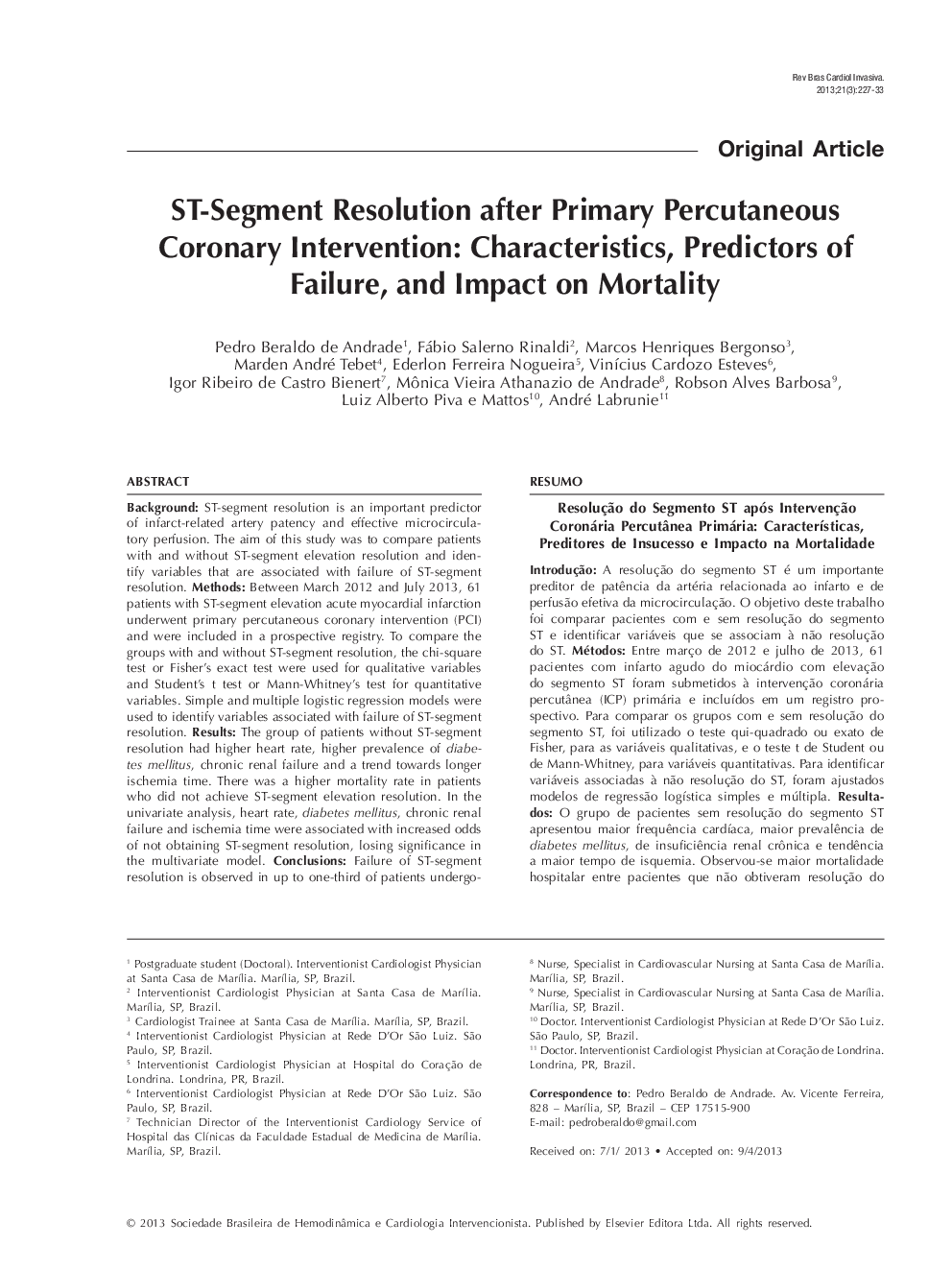| Article ID | Journal | Published Year | Pages | File Type |
|---|---|---|---|---|
| 3011849 | Revista Brasileira de Cardiologia Invasiva (English Edition) | 2013 | 7 Pages |
ABSTRACTBackgroundST-segment resolution is an important predictor of infarct-related artery patency and effective microcirculatory perfusion. The aim of this study was to compare patients with and without ST-segment elevation resolution and identify variables that are associated with failure of ST-segment resolution.MethodsBetween March 2012 and July 2013, 61 patients with ST-segment elevation acute myocardial infarction underwent primary percutaneous coronary intervention (PCI) and were included in a prospective registry. To compare the groups with and without ST-segment resolution, the chi-square test or Fisher’s exact test were used for qualitative variables and Student’s t test or Mann-Whitney’s test for quantitative variables. Simple and multiple logistic regression models were used to identify variables associated with failure of ST-segment resolution.ResultsThe group of patients without ST-segment resolution had higher heart rate, higher prevalence of diabetes mellitus, chronic renal failure and a trend towards longer ischemia time. There was a higher mortality rate in patients who did not achieve ST-segment elevation resolution. In the univariate analysis, heart rate, diabetes mellitus, chronic renal failure and ischemia time were associated with increased odds of not obtaining ST-segment resolution, losing significance in the multivariate model.ConclusionsFailure of ST-segment resolution is observed in up to one-third of patients undergoing primary PCI and requires new pharmacologic strategies or interventions to minimize it.
RESUMOResolução do Segmento ST após Intervenção Coronária PercutâneaPrimária: Características, Preditores de Insucesso e Impacto na MortalidadeIntroduçãoA resolução do segmento ST é um importante preditor de patência da artéria relacionada ao infarto e de perfusão efetiva da microcirculação. O objetivo deste trabalho foi comparar pacientes com e sem resolução do segmento ST e identificar variáveis que se associam à não resolução do ST.MétodosEntre março de 2012 e julho de 2013, 61 pacientes com infarto agudo do miocárdio com elevação do segmento ST foram submetidos à intervenção coronária percutânea (ICP) primária e incluídos em um registro prospectivo. Para comparar os grupos com e sem resolução do segmento ST, foi utilizado o teste qui-quadrado ou exato de Fisher, para as variáveis qualitativas, e o teste t de Student ou de Mann-Whitney, para variáveis quantitativas. Para identificar variáveis associadas à não resolução do ST, foram ajustados modelos de regressão logística simples e múltipla.ResultadosO grupo de pacientes sem resolução do segmento ST apresentou maior frequência cardíaca, maior prevalência de diabetes mellitus, de insuficiência renal crônica e tendência a maior tempo de isquemia. Observou-se maior mortalidade hospitalar entre pacientes que não obtiveram resolução do ST. Pela análise univariada, as variáveis frequência cardíaca, diabetes mellitus, insuficiência renal crônica e tempo de isquemia associaram-se à maior chance de não resolução do ST, perdendo significância no modelo multivariado.ConclusõesA não resolução do segmento ST pode ocorrer em até um terço dos pacientes submetidos à ICP primária, requerendo o advento de novas estratégias farmacológicas ou de intervenção capazes de minimizá-la.
